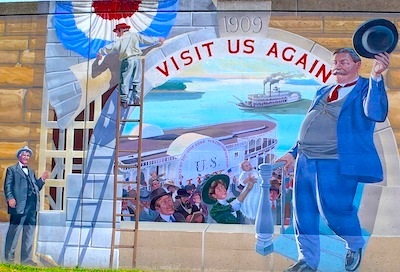Cape Girardeau, Missouri- A Shore Excursion to the floodwalls
Floodwalls in river towns certainly perform a very useful service. But they also can be a blank canvas for creative people.
One of the floodwalls I always enjoy seeing is located in Cape Girardeau where riverboats tend to stop.
In the 1730s, a young Frenchman named Jean Baptiste Girardot established a trading post at a rock promontory jutting from the west bank of the Mississippi River. This large promontory was referred to as “the cape,” a significant headland projecting well into the river.
However, Girandot was a trader, not a settler, and by the middle of the 1700s, Girardot had moved on. His name with some spelling changes remained.
Although the Mississippi River was the reason Cape Girardeau exists, the mighty muddy Mississippi has also been devastating to the community. Every few years, the river would ravage the downtown area, wiping out businesses and bankrupting proprietors.
In order for the city to survive, something had to be done to tame the river. Plans took decades. “In 1956 work began on our flood wall to protect Cape Girardeau,” said guide Linda Hill. “The wall was finished in 1964 at a cost of $4 million.”
The huge wall has saved the historic downtown area many times over, particularly during the historic flood of 1993 when the river crested at 48,49 feet, nearly 17 feet above flood stage.
Since the city had such a large blank canvas, folks decided to turn it into a work of art. The result is the Mississippi River Tales Mural with its pictorial history of the region and the Missouri Wall of Fame, featuring dozens of famous and infamous Missourians.
Dedicated in 2005, the 1,100-foot-long Mississippi River Tales Mural has 24 panels seeming to be in 3D, leaping out at viewers.
“It looks as though the wall is made out of stone but it’s not. It’s just concrete but it was painted to look like stone,” Linda said.
My favorite two panels are the “1803 Lewis and Clark” and the “1909 President Taft’s Visit.” On Nov. 23, 1803, Meriwether Lewis and William Clark stopped at Cape Girardeau to deliver letters of introduction to Louis Lorimier, another Frenchman who was given a land grant to the area in 1793 and established a trading post. Lewis found Lorimier presiding at a horse race.
Strolling back to my riverboat, I passed the mural honoring William Howard Taft’s visit to Cape Girardeau on Oct. 26, 1909. The first sitting President to visit the city, Taft was part of a 16-boat flotilla carrying a large number of dignitaries who came down the river to publicize the developing effort to stabilize and deepen the river channel.
An estimated 25,000 turned out to hear Taft speak. It was such a great celebration that for years after that date was known as “Taft Day.”
Story and photo by Jackie Sheckler Finch















View Recent Comments